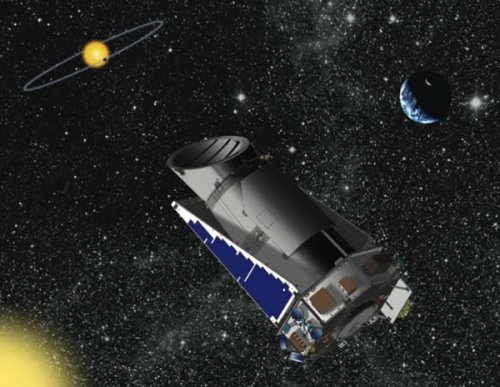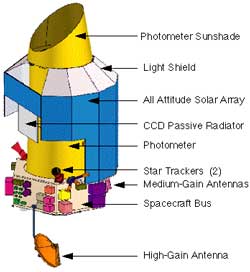Kepler Mission

The Kepler Mission is a mission in NASA's Discovery Program designed to detect and characterize Earth-class planets by photometry. Kepler was launched successfully on 6 May 2009, into an Earth-trailing, heliocentric (Sun-centered) orbit.
Kepler's specific objectives over its 4-year lifetime are to determine: (a) the frequency of Earth-class and larger planets in and near the habitable zone of a wide variety of spectral types of stars; (b) the distribution of diameter and orbital size of Earth-class planets; (c) the distribution of diameter, mass, density, albedo, and orbital size of giant inner planets; (d) the frequency of planets orbiting multiple star systems; and (e) the properties of those stars that have planetary systems.
Kepler's main instrument is a 1-meter aperture photometer with a 12° field of view which will continuously and simultaneously monitor the light from 90,000 main sequence stars brighter than 14th magnitude in a star field in Cygnus. Planets will be discovered and characterized by the tiny periodic variations their transits cause in a star's measured light output. Detection of two transits will be taken as evidence of a candidate planet with a third and subsequent transits providing confirmation.
Quick facts about Kepler from JPL
 |
· Kepler is the world's first mission with the ability to find true Earth analogs – planets that orbit stars like our sun in the "habitable zone." The habitable zone is the region around a star where the temperature is just right for water – an essential ingredient for life as we know it – to pool on a planet's surface.
· By the end of Kepler's three-and-one-half-year mission, it will give us a good idea of how common or rare other Earths are in our Milky Way galaxy. This will be an important step in answering the age-old question: Are we alone?
· Kepler detects planets by looking for periodic dips in the brightness of stars. Some planets pass in front of their stars as seen from our point of view on Earth; when they do, they cause their stars to dim slightly, an event Kepler can see.
· Kepler has the largest camera ever launched into space, a 95-megapixel array of charge-coupled devices, or CCDs, like those in everyday digital cameras.
· Kepler's telescope is so powerful that, from its view up in space, it could detect one person in a small town turning off a porch light at night.


